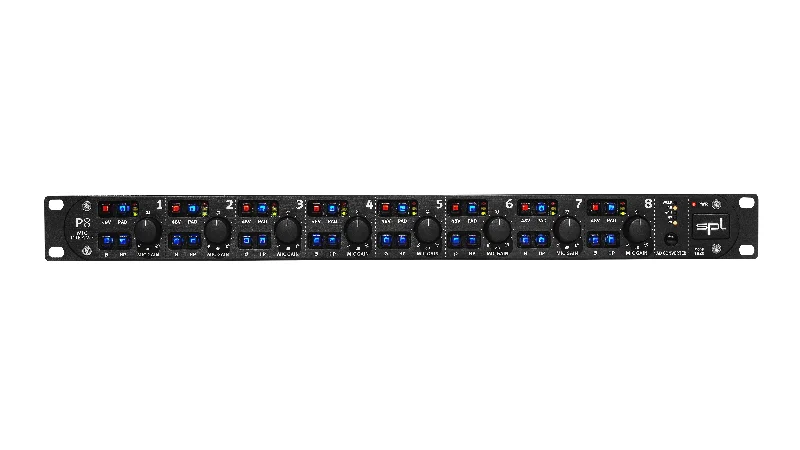P8 is equipped with eight identically designed microphone preamplifiers. All eight preamps have a discrete design – without ICs, made of individual transistors. This is typical for absolute high-end preamplifiers and is one of the main reasons for the outstanding sound.
Besides an analog gain control for adjusting the preamplification, each of the eight preamps features an individually switchable phantom power supply (48 V), a PAD switch, a phase inversion function and a switchable analog high-pass filter.
With the optional eight-channel ADAT converter, the purely analog P8 can be digitally connected to an audio interface.
Preamps
P8 is equipped with eight preamplifiers. These have a discrete design and they are tuned for a sound- neutral, open and transparent characteristic.
Mic Gain
The gain control can be used to adjust the preamplification. The control range ranges between +8 dB und +62 dB – so even really demanding microphones can unfold their full potential!
48V
Each of the eight preamplifiers has a 48V switch. This switch activates the required phantom power of 48 volts for the use of condenser microphones.
PAD
The PAD switch in the respective preamplifier section attenuates the
signal of the microphone input by 20 dB, so that even very high levels
can be processed with the P8. This is the case, for example, with loud percussion or bass recordings.
Ø
The phase reverse function of every preamplifier reverses the polarity of the signal. After pressing the switch, the phase is reversed by 180°.
HP
A high-pass filter with 6 dB per octave is also available in each of the
eight preamp sections and, when activated, reduces subsonic noise
below 80 Hz.
Microphone inputs
The eight microphone inputs of the P8 are equipped with Neutrik XLR sockets and gold-plated contacts. The signal transmission is electronically balanced, at a nominal level of 0 dBu.
Line outputs (analog)
In the version without optional AD converter, P8 has two DB25 sockets at the output stage. Both of these provide the analog line level output signal from microphone preamps 1 to 8.
The analog output signal can be connected to a multi-channel AD converter, for example, with the DB25 input common to this type of device, and in parallel to a second recording device.
An additional external signal splitter for back-up systems during a recording session is therefore no longer necessary.
Specifications
Analog inputs & output; XLR (balanced)
- Maximum input gain (Mic, +8 dB – +62 dB): 13.5 dBu (33.5 dBu with PAD)
- Input impedance (Mic/Line): 10 kΩ
- Output impedance: 75 Ω
- Frequency range: 15 Hz – 200 kHz
- Equivalent Input Noise (EIN): -124 dBu
- Noise (A-weighted, Mic Preamp, 150 Ω, 30 dB Gain): -94 dBu
- Rausc (A-weighted, Mic Preamp, 150 Ω, 62 dB Gain): -66 dBu
- Common mode rejection (1 kHz): < 78 dB
- THD+N Ratio (1 kHz), Mic 30 dB Gain: 0.003 %
- THD+N Ratio (1 kHz), Mic 62 dB Gain (Max.): 0.022 %
- Signal display/meter
- Green: -25 dBu
- Yellow: 0 dBu
- Red: +19 dBu (without AD converter), +12 dBu / -3 dBFs (with AD converter)
Internal Linear Power Supply with Shielded Toroidal Transformer
- Operating voltage for analog audio +/- 17 V
- Operating voltage for relays und LEDs +18 V
- Phantom power +48 V
- Operating voltage for AD converter +12 V/+3,3 V
Mains Power Supply
- Mains voltage (selectable, see fuse chamber) 230 V AC / 50; 115 V AC / 60 Hz
- Fuse 230 V T 315 mA
- Fuse 115 V T 630 mA
- Power consumption max. 27 VA
Dimensions & Weight
- W x H x D (width x height x depth) 482 x 44 x 237 mm / 19 x 1.73 x 9.33 inch
- Unit weight 4.15 kg / 9.15 lbs
- Shipping weight (incl. package) 5.4 kg / 11.9 lb

